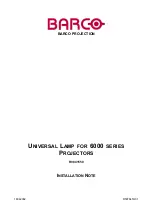
3
SG4 EXTENDED
ALIGNMENT PROCEDURE
The alignment between the emitting and the receiving units is necessary to obtain the correct functioning
of the light curtain. A good alignment prevents output instability caused by dust or vibrations.
After correct mechanical mounting and electrical wiring user should proceed to alignment procedure and
verify results according to next table. To enter SG4-E dedicated Alignment Mode activate RESET/RESTART/
ALIGN input during Power-On until OSSD red led blinks.
The alignment is perfect if the optical axes of the first and the last emitting unit beams coincide with the
optical axes of the corresponding elements of the receiving unit.
Both first (near the connector) and last beam are used for optical SYNC.
No Sync, check SYNC1
NONE
OFF
SYNC 1 aligned
NONE
OFF
SYNC 2 aligned
NONE
OFF
One or more intermedi-
ate beams not aligned
NONE
OFF
All beams aligned
BAD
ON
All beams aligned
ON
All beams aligned
ON
All beams aligned
EXCELLENT
ON
A. Keep the receiver in a steady position and set the emitter until the yellow SYNC 1 LED is OFF. This
condition shows the effective alignment of the first synchronisation beam.
B. Rotate the emitter, pivoting on the lower optics axis, until the yellow SYNC 2 LED is OFF.
C. Delimit the area in which alignment is good and steady through some micro adjustments - for the
first and then for the second unit - so to have the maximum alignment LEVEL ( ) and then place
both units in the center of this area.
D. Fix the two units firmly using brackets. Verify that the LEVEL on the RX unit is as high as possible and
beams are not interrupted, then verify that all LEVEL Led turns OFF if even one single beam is inter-
rupted. This verification shall be made with the special cylindrical “Test Piece” having a size suitable
to the resolution of the device used (refer to “Checks after first installation” of the Instruction Man-
ual).
E. Switch OFF and ON the device in standard operating mode. The alignment level is monitored also
during device normal operation with the same display. Once the light curtain has been aligned and
correctly fastened, the display signal is useful both to check the alignment and show a change in the
environmental conditions (occurrence of dust, light disturbance and so on) via signal level monitor-
ing.
INDICATION
RX LED CONFIGURATION
ALIGNMENT
STATUS
OSSD STATUS IN
NORMAL OPERATION






























